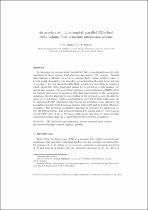 ResearchSpace
ResearchSpace
An accelerated, fully-coupled, parallel 3D hybrid finite-volume fluid–structure interaction scheme
JavaScript is disabled for your browser. Some features of this site may not work without it.
- ResearchSpace
- →
- Research Publications/Outputs
- →
- Journal Articles
- →
- View Item
| dc.contributor.author |
Malan, AG

|
|
| dc.contributor.author |
Oxtoby, Oliver F

|
|
| dc.date.accessioned | 2012-11-21T11:40:42Z | |
| dc.date.available | 2012-11-21T11:40:42Z | |
| dc.date.issued | 2012-09 | |
| dc.identifier.citation | Malan, AG and Oxtoby, OF. 2012. An accelerated, fully-coupled, parallel 3D hybrid finite-volume fluid–structure interaction scheme. Computer Methods in Applied Mechanics and Engineering, vol. 253, pp 426-438 | en_US |
| dc.identifier.issn | 0045-7825 | |
| dc.identifier.uri | http://www.sciencedirect.com/science/article/pii/S0045782512002794 | |
| dc.identifier.uri | http://hdl.handle.net/10204/6351 | |
| dc.description | Copyright: 2012 Elsevier. This is the pre-print version of the item. The definitive version is published in Computer Methods in Applied Mechanics and Engineering, vol. 253, pp 426-438 | en_US |
| dc.description.abstract | In this paper we propose a fast, parallel 3D, fully-coupled partitioned hybridunstructured finite volume fluid–structure-interaction (FSI) scheme. Spatial discretisation is effected via a vertex-centered finite volume method, where a hybrid nodal-elemental strain procedure is employed for the solid in the interest of accuracy. For the incompressible fluid, a split-step algorithm is presented which allows the entire fluid-solid system to be solved in a fully-implicit yet matrix-free manner. The algorithm combines a preconditioned GMRES solver for implicit integration of pressures with dual-timestepping on the momentum equations, thereby allowing strong coupling of the system to occur through the inner solver iterations. Further acceleration is provided at little additional cost by applying LU-SGS relaxation to the viscous and advective terms. The solver is parallelised for distributed-memory systems using MPI and its scaling efficiency evaluated. The developed modelling technology is evaluated by application to two 3D FSI problems. The advanced matrix-free solvers achieve reductions in overall CPU time of up to 50 times, while preserving close to linear parallel computing scaling using up to 128 CPUs for the problems considered. | en_US |
| dc.language.iso | en | en_US |
| dc.publisher | Elsevier | en_US |
| dc.relation.ispartofseries | Workflow;9739 | |
| dc.relation.ispartofseries | Workflow;9888 | |
| dc.subject | 3D fluid-structure-interaction | en_US |
| dc.subject | Vertex-centered finite volume | en_US |
| dc.subject | Algorithms | en_US |
| dc.subject | Modelling technologies | en_US |
| dc.title | An accelerated, fully-coupled, parallel 3D hybrid finite-volume fluid–structure interaction scheme | en_US |
| dc.type | Article | en_US |
| dc.identifier.apacitation | Malan, A., & Oxtoby, O. F. (2012). An accelerated, fully-coupled, parallel 3D hybrid finite-volume fluid–structure interaction scheme. http://hdl.handle.net/10204/6351 | en_ZA |
| dc.identifier.chicagocitation | Malan, AG, and Oliver F Oxtoby "An accelerated, fully-coupled, parallel 3D hybrid finite-volume fluid–structure interaction scheme." (2012) http://hdl.handle.net/10204/6351 | en_ZA |
| dc.identifier.vancouvercitation | Malan A, Oxtoby OF. An accelerated, fully-coupled, parallel 3D hybrid finite-volume fluid–structure interaction scheme. 2012; http://hdl.handle.net/10204/6351. | en_ZA |
| dc.identifier.ris | TY - Article AU - Malan, AG AU - Oxtoby, Oliver F AB - In this paper we propose a fast, parallel 3D, fully-coupled partitioned hybridunstructured finite volume fluid–structure-interaction (FSI) scheme. Spatial discretisation is effected via a vertex-centered finite volume method, where a hybrid nodal-elemental strain procedure is employed for the solid in the interest of accuracy. For the incompressible fluid, a split-step algorithm is presented which allows the entire fluid-solid system to be solved in a fully-implicit yet matrix-free manner. The algorithm combines a preconditioned GMRES solver for implicit integration of pressures with dual-timestepping on the momentum equations, thereby allowing strong coupling of the system to occur through the inner solver iterations. Further acceleration is provided at little additional cost by applying LU-SGS relaxation to the viscous and advective terms. The solver is parallelised for distributed-memory systems using MPI and its scaling efficiency evaluated. The developed modelling technology is evaluated by application to two 3D FSI problems. The advanced matrix-free solvers achieve reductions in overall CPU time of up to 50 times, while preserving close to linear parallel computing scaling using up to 128 CPUs for the problems considered. DA - 2012-09 DB - ResearchSpace DP - CSIR KW - 3D fluid-structure-interaction KW - Vertex-centered finite volume KW - Algorithms KW - Modelling technologies LK - https://researchspace.csir.co.za PY - 2012 SM - 0045-7825 T1 - An accelerated, fully-coupled, parallel 3D hybrid finite-volume fluid–structure interaction scheme TI - An accelerated, fully-coupled, parallel 3D hybrid finite-volume fluid–structure interaction scheme UR - http://hdl.handle.net/10204/6351 ER - | en_ZA |





